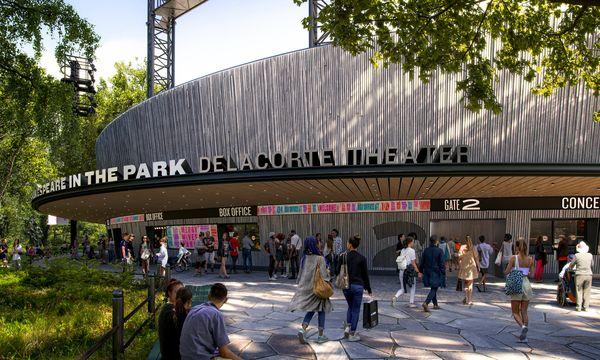
Rendering by Ennead Architects
The Public Theater, in partnership with Central Park Conservancy and the NYC Parks, has unveiled its plans for a much-needed revitalization of the 59-year-old Delacorte Theater in Central Park. The proposal will now move through a robust public engagement process with local Community Boards, the Landmarks Preservation Commission, and other stakeholders.
With more than six decades of operation, including the recent staging of the widely-acclaimed performances of Merry Wives, Much Ado About Nothing, Hercules and Twelfth Night, and more than five million tickets given away, Shakespeare in the Park is one of New York City’s most iconic cultural experiences.
Advertisement
However, the theater has outlasted its current facility in almost every measurable way. The renovation of The Delacorte is not optional: the deteriorating structure is in dire need of rebuilding to provide upgraded and more comfortable conditions for staff, artists and audiences alike. It lacks modern back-of-house theatrical operations and does not ensure equitable access for those living with disabilities.
The Public first announced its plans to renovate in 2018, and since then has toured hundreds of people through the theater including local residents, community board members, Public supporters, volunteer Central Park gardeners, historic preservation groups, public school teachers, teaching artists, and others to share the current state of the facility and the goals of its proposed project.
Over the last several years, the Public worked with park stakeholders and design experts to closely study the potential impact of construction on the surrounding natural environment and arrived at a plan which will take great care to protect it. Central Park is not only crucial to the experience of Shakespeare in the Park; it is the backdrop that inspires its actors and captivates its audiences.
Built in 1962, the theater has not undergone meaningful capital upgrades since 1999. The design comprehensively addresses the theater’s code and life safety needs, makes core improvements to infrastructure and backstage efficiency, and makes substantial upgrades to support its theatrical program. The design is also contextual and maintains The Delacorte’s current form, footprint and views within the park while protecting the sanctity of the theater in the park experience.
Key proposed design elements include:
- Accessible and comfortable space for audiences and artists living with disabilities: Built before many of the modern accessibility codes, the existing Delacorte possesses only one access point for people living with disabilities and only one row of seating in the front row on house right. The proposed design will bring the whole theater in line with current code, focusing on maximizing accessibility– making two gates accessible for people who use wheelchairs, adding stage accessibility interventions to make the stage accessible for artists with disabilities, and creating an accessible cross aisle to provide people who use wheelchairs a more equitable experience of attending performances at The Delacorte.
- Streamlined backstage operations and improved comfort for cast and crew: The new design improves inefficiencies across the theater which will decrease time needed for load in, load out and change between productions. Back-of-house investments are also aimed at improving the staff and artist experience, with purpose-built dressing rooms, bigger hallways, and climate control for enclosed spaces.
- Revitalized exterior for a more dynamic aesthetic experience: The theater’s exterior wall will be canted slightly outward to give The Delacorte a dynamic presence and movement. The textured wood façade plays with light and shadow, complementing the natural setting of trees and overhead foliage. The new covered canopy and widened bluestone pathway will welcome visitors, provide more generous circulation and increased shelter from rain and sun. Nestled in the natural treescape of Central Park, the seating will comprise a diverse range of colors both blending with and enhancing the seasonal changes of the surroundings.
- A focus on resilience and sustainability: The existing decking has sustained significant damage that has caused numerous points of rebuild for each season. As weather fluctuates more wildly and storms get more unpredictable, that level of constant repair is only expected to grow unless serious investments are made. The proposed design contemplates the use of products that have been approved by NYC Parks and used throughout that are more durable and sustainable with the changing elements; improved drainage around the site will help plan for storms of greater strength and unpredictability.
- Lighting improvements: Newly-designed lighting towers will provide improved lighting for the stage and performances, adding to the overall theatrical experience and ambiance. The new towers will also include additional safety features for crew members and increase efficiency for load in and load out of shows.
The Public is also in conversations with the City Parks Department to improve and expand the comfort stations which serve as the theater’s restrooms during performances.
Advertisement
The project team will prioritize diverse hiring as it invests in New York’s cultural infrastructure post-pandemic. It has committed to exceeding the City and State’s minimum requirements for contracting Minority and Women-owned Business Enterprises and Locally-based Business Enterprises (MWBEs and LBEs), including at least 40% MWBE/LBE subcontracting and 30% construction participation from underserved communities, in keeping with The Public’s anti-racism and cultural transformation plan.
The project is designed by Ennead Architects, which also oversaw the revitalization of the facade and public spaces at the Public’s flagship location on Lafayette Street in 2012 and the recent renovation of the Rehearsal Annex, part of a five-phase master plan for The Public Theater. Ennead has led many other marquee cultural revitalization projects in New York, including the Brooklyn Museum entry pavilion and plaza, Jazz at Lincoln Center, Symphony Space, Zankel Hall at Carnegie Hall, and the Rose Center for Earth and Space at the American Museum of Natural History. This continued relationship is based on shared commitments to creating spaces that center radical welcome and equity.
The theater project is expected to cost $77 million, with $41 million contributed by the Mayor, City Council and Manhattan Borough President and the rest privately raised. Pending approvals, work is anticipated to start in fall of 2022.



“$41 million will be contributed by the mayor, city council , and borough president “. Not quite . It should read “$41 million to come from public taxes.”